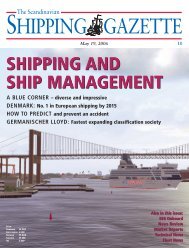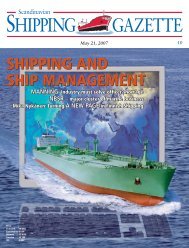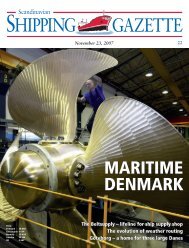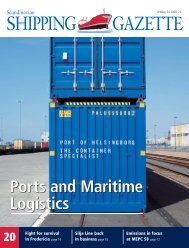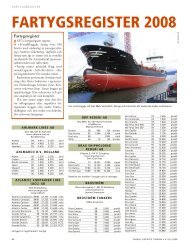SSG No 20 - Shipgaz
SSG No 20 - Shipgaz
SSG No 20 - Shipgaz
Create successful ePaper yourself
Turn your PDF publications into a flip-book with our unique Google optimized e-Paper software.
PORTS & MARITIME LOGISTICS<br />
Rostock: passengers rule but could boxes now come?<br />
of HHLA and the LHG are known, along<br />
with their financial involvement.<br />
Another record at Bremen<br />
The port complex of Bremen/Bremerhaven<br />
is “on track for another record year”, said<br />
new Ports and Economics Senator Ralf<br />
Nagel, after what was officially termed a<br />
“sensational” <strong>20</strong>06.<br />
The Weser saw throughput rise <strong>20</strong> per<br />
cent last year and 8 per cent in the first half<br />
of <strong>20</strong>07 to 34 million tons. Boxes were up<br />
11 per cent to 2.3 million TEUs, putting 5<br />
million TEUs within reach.<br />
Nagel said current CT 4 expansion of<br />
Bremerhaven’s Wilhelm Kaisen Container<br />
Terminal was just in time to cope with<br />
growth. The last of four new berths there<br />
is due into service in the first half of next<br />
year and reports now say the entire terminal<br />
will be in full operation by next Autumn.<br />
The expansion is the final stage of container<br />
development. The port can expand no<br />
further and will be looking to its new “big<br />
brother”, the deepwater JWP in nearby Wilhelmshaven,<br />
to cope with future increases as<br />
Bremerhaven settles into a feeder hub role.<br />
The Weser ports have meanwhile<br />
unveiled a campaign to improve inner-port<br />
development and hinterland links, joining<br />
Hamburg in its concern over those issues.<br />
Ralf Nagel said political priority must be<br />
given to improving roads, railways and<br />
waterways, which he said were not ready<br />
for the cargo the future would bring.<br />
Vehicle handling sharply ahead<br />
Vehicle handling is another sector to show<br />
double-digit growth on the Weser in the<br />
first half of <strong>20</strong>07, with nearly a million<br />
vehicles handled, or 12 per cent more. That<br />
lends credence to predictions it will pass<br />
the two million mark this year and regain<br />
the European lead currently held by Zeebrugge.<br />
Already operational new facilities<br />
in the Osthafen and other improvements<br />
costing EUR 233 million will increase the<br />
Weser’s chances.<br />
Germany’s second biggest car hub,<br />
Emden, also expects <strong>20</strong>07 to be another<br />
record year for vehicles. It hopes to pass<br />
the one million mark this year and also the<br />
6.15 million ton overall handling figure of<br />
<strong>20</strong>06.<br />
In Germany’s biggest easternmost seaport,<br />
Rostock, port chief Ulrich Bauermeister<br />
indicated there is profit to be made<br />
from the hinterland problems Bremerhaven<br />
and Hamburg are facing in the west.<br />
He said that, because of port congestion,<br />
some <strong>No</strong>rth-South container traffic might<br />
Brake<br />
expansion<br />
is par for<br />
German<br />
course.<br />
find its way back to Rostock. If it did, the<br />
port was quite capable of handling it, he<br />
said.<br />
Containers have played little part in the<br />
fast development of the former GDR port<br />
since 1990, when lines moved to Hamburg<br />
and Bremerhaven. Several unsuccessful<br />
efforts have been made since then to reestablish<br />
container shipping in Rostock.<br />
Bauermeister warns against too great hopes<br />
now, saying that Rostock was not about to<br />
develop into a container port.<br />
He did say however that in sectors in<br />
which Rostock had done well since 1990,<br />
business would continue to boom.<br />
He predicted that by <strong>20</strong>15 truck/trailer<br />
traffic would nearly double, passenger<br />
totals would rise <strong>20</strong> per cent and bulk cargo<br />
would increase by about 30 per cent.<br />
Rostock increases growth<br />
Cargo handling rose eight per cent in Rostock<br />
in the first half of <strong>20</strong>07 to 13.1 million<br />
tons after 26.8 million tons overall in <strong>20</strong>06.<br />
Bauermeister said Rostock had “successfully<br />
overcome the difficult structural transformation<br />
of the 1990s and is consistently<br />
increasing its growth”.<br />
Typical of the expansion in German<br />
ports to cope with rising traffic demands<br />
is Brake on the Lower Weser, where construction<br />
has begun on a EUR 37.5 million<br />
project. A new 270 m quayside, costing<br />
EUR 14.5 million, is being built to <strong>20</strong>09<br />
with road and rail facilities behind two<br />
berths. The facility can be expanded later<br />
by 180 m to 450 m. Brake handled 2.3 million<br />
tons in the first half of this year after<br />
5.5 million tons in the whole of <strong>20</strong>06. Officials<br />
said its existing facilities have reached<br />
saturation point.<br />
tom todd<br />
54 SCANDINAVIAN SHIPPING GAZETTE • OCTOBER 26, <strong>20</strong>07




